Class 10 Exam > Class 10 Notes > Physics for GCSE/IGCSE > Dangers of Electromagnetic Waves
Dangers of Electromagnetic Waves | Physics for GCSE/IGCSE - Class 10 PDF Download
Dangers of Electromagnetic Waves
- As the frequency of electromagnetic (EM) waves rises, their energy also increases.
- Once beyond the visible spectrum, the energy of EM waves becomes sufficient to ionize atoms.
- Consequently, the risk associated with EM waves escalates alongside their frequency.
- Shorter wavelengths indicate more ionizing radiation.
- However, the intensity of a wave also holds significant importance.
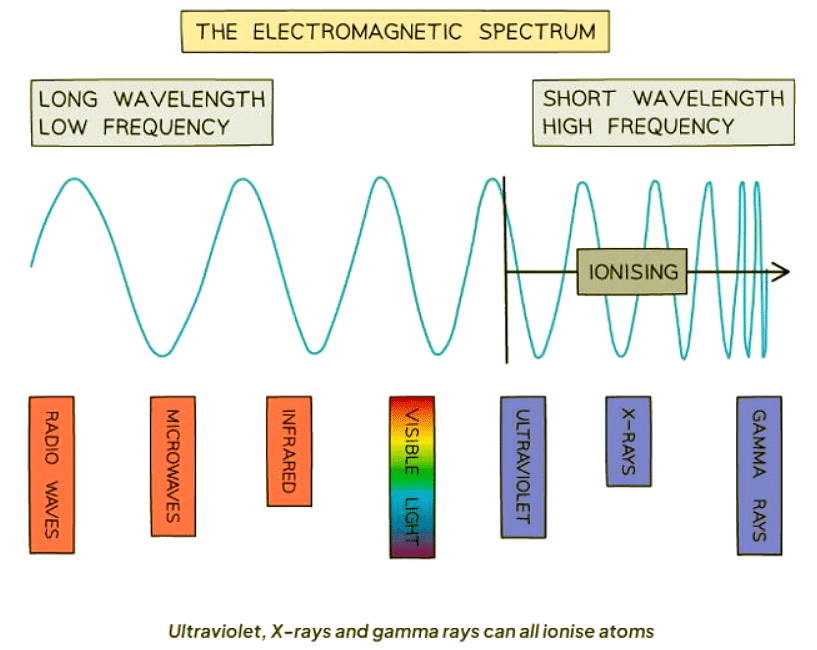
- Due to ionization, ultraviolet waves, X-rays, and gamma rays can pose risks to human body tissue.
- The impact varies based on the radiation type and the dosage.
- These waves have the potential to harm cells and induce mutations, leading to cancer.
- Broadly, electromagnetic waves become increasingly hazardous as their wavelengths shorten.
- For instance, radio waves lack known harmful effects, whereas gamma rays, highly perilous, can induce cancer.
- The primary dangers associated with electromagnetic waves are outlined in the following table:
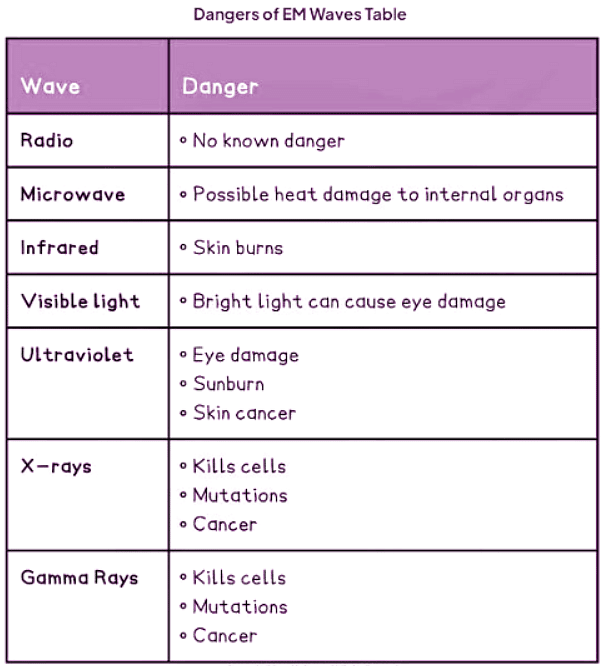
- The uses and hazards of various EM waves are outlined in the diagram provided below:
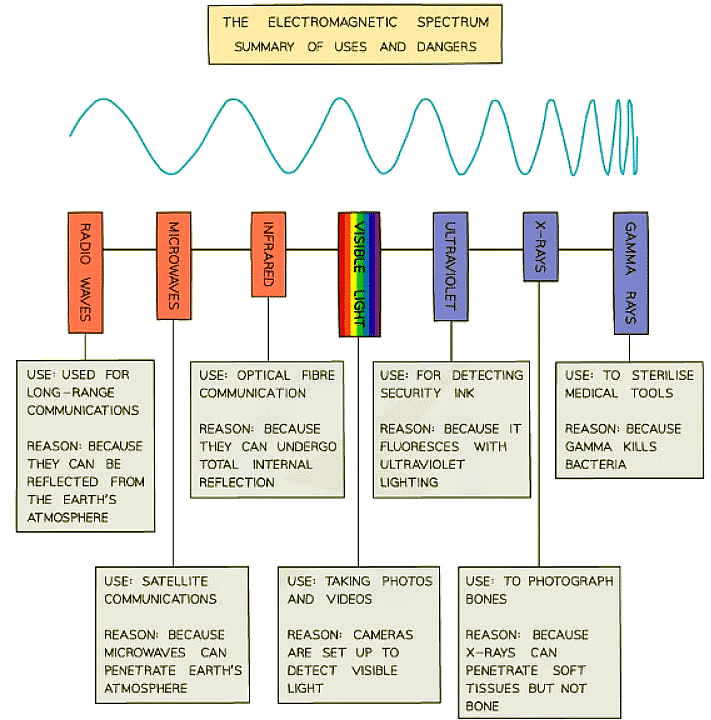
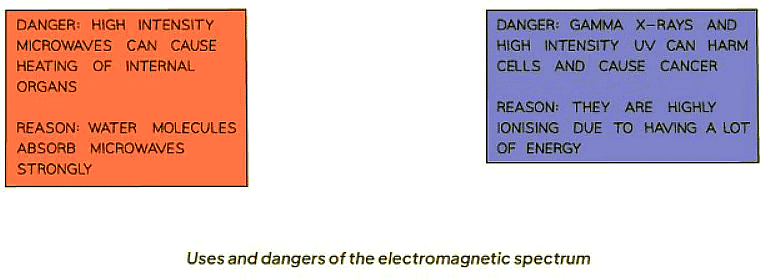
Microwaves
- Certain frequencies of microwaves are absorbed by water molecules
- Since humans have a high water content, there is a risk of internal heating from microwaves
- Microwaves used in everyday circumstances, like those in mobile phones, emit small amounts of energy and are considered safe
- Microwave ovens emit large amounts of energy, but the metal walls and grid in the glass door prevent the energy from escaping
- Microwaves used for communication, such as in mobile phones, emit low levels of energy that are considered safe.
- Microwave ovens emit high amounts of energy, but the metal walls and grid in the glass door contain this energy.
- Microwaves in communication devices emit safe levels of energy.
- Microwave ovens trap high energy levels within their metal construction.
Ultraviolet (UV) Radiation
- UV radiation, invisible to the human eye, carries high energy levels.
- Excessive UV exposure can lead to severe eye damage, but quality sunglasses can block UV rays.
- High levels of UV exposure can cause significant harm to the eyes.
- UV radiation can be ionizing, potentially harming cells and leading to conditions like premature aging and skin cancer.
- Sunscreen helps prevent UV damage to the skin.
X-rays and Gamma Rays
- X-rays and gamma rays are highly ionizing forms of electromagnetic waves.
- They can penetrate the body, leading to internal damage and potential gene mutations that may cause cancer.
- These rays have the capability to cause internal harm and genetic mutations, which can result in cancer.
- In medicine, X-ray levels are kept minimal to reduce risks. Doctors limit exposure by leaving the room during scans.
- Professionals handling gamma rays take precautions to minimize exposure and undergo regular radiation dose monitoring.
- Medical staff like radiographers wear radiation badges to measure their exposure levels.
- When taking X-rays, doctors will exit the room to prevent unnecessary exposure.
- Individuals handling gamma rays must take various precautions to minimize their exposure and undergo regular radiation dose assessments.
- For instance, medical professionals like radiographers wear radiation badges to gauge their radiation exposure levels.
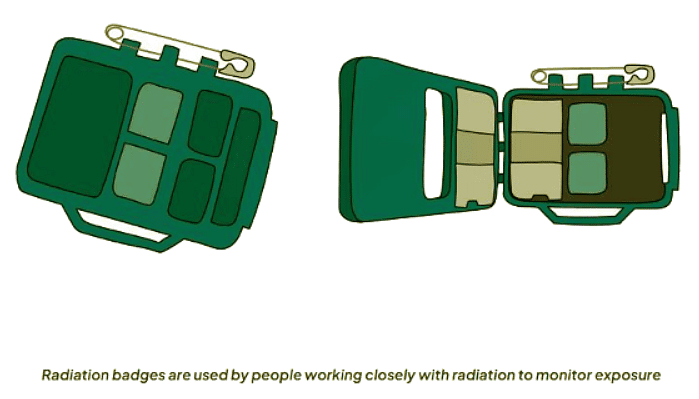
Question for Dangers of Electromagnetic WavesTry yourself: What is the primary danger associated with ultraviolet (UV) radiation?View Solution
The document Dangers of Electromagnetic Waves | Physics for GCSE/IGCSE - Class 10 is a part of the Class 10 Course Physics for GCSE/IGCSE.
All you need of Class 10 at this link: Class 10
|
126 videos|182 docs|35 tests
|
FAQs on Dangers of Electromagnetic Waves - Physics for GCSE/IGCSE - Class 10
| 1. What are electromagnetic waves and how do they pose dangers to humans? |  |
Ans. Electromagnetic waves are a form of energy emitted by electronic devices and power lines. They can pose dangers to humans by potentially causing health issues such as headaches, sleep disturbances, and even cancer due to their ability to penetrate the human body.
| 2. How can one limit exposure to electromagnetic waves in everyday life? |  |
Ans. To limit exposure to electromagnetic waves, one can reduce the use of electronic devices, keep a safe distance from power lines and electrical appliances, and use shielding materials such as special paints or fabrics to block out electromagnetic radiation.
| 3. Are certain individuals more susceptible to the dangers of electromagnetic waves? |  |
Ans. Yes, some individuals may be more susceptible to the dangers of electromagnetic waves, such as pregnant women, children, and individuals with pre-existing health conditions. They may experience more severe health effects from prolonged exposure to electromagnetic radiation.
| 4. Can electromagnetic waves from cell phones and Wi-Fi routers affect our health? |  |
Ans. There is ongoing research on the potential health effects of electromagnetic waves from cell phones and Wi-Fi routers. While some studies suggest a possible link to health issues, conclusive evidence is still lacking. It is recommended to limit exposure to such devices as a precaution.
| 5. How can one create a safe environment in terms of electromagnetic waves at home or in the workplace? |  |
Ans. To create a safe environment in terms of electromagnetic waves, one can use wired connections instead of wireless devices whenever possible, turn off electronic devices when not in use, and place electronic devices at a distance from where people spend most of their time.
Related Searches
















